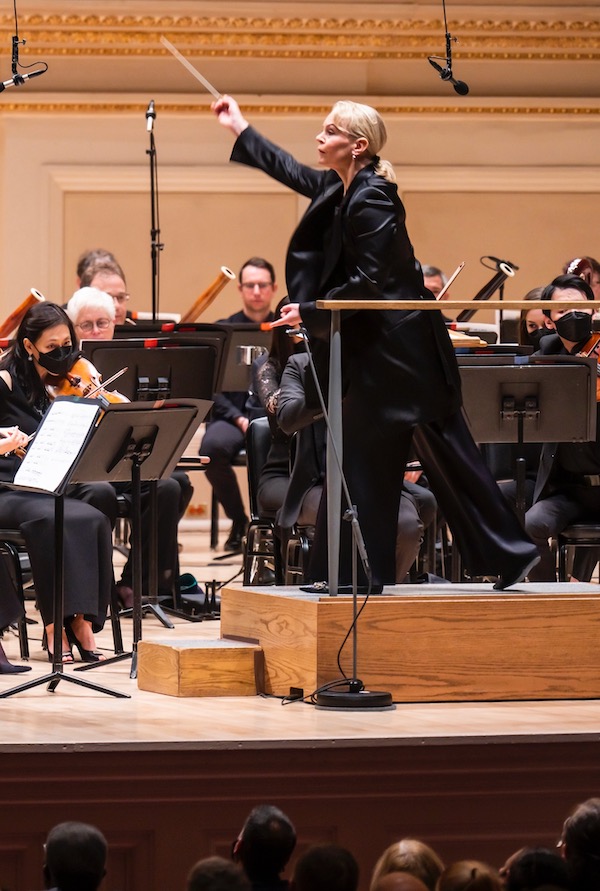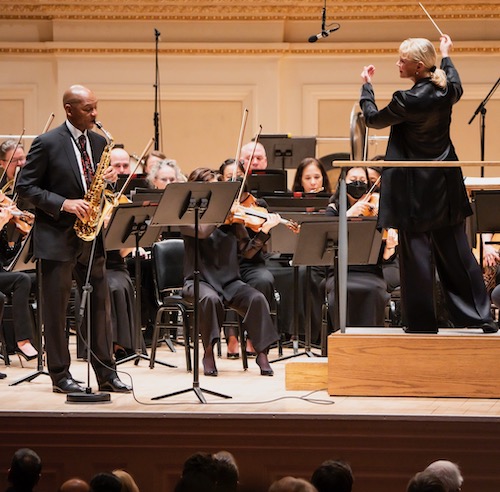Mälkki leads commanding Philharmonic performances in Carnegie Hall debut

There were certain odd qualities to the New York Philharmonic’s concert Thursday night in Carnegie Hall. One was that the Philharmonic was appearing for one night only as a visiting orchestra, less than a dozen blocks from their usual home in Lincoln Center. The other was the sense of anticipation with which the audience greeted guest conductor Susanna Mälkki, who was making her Carnegie debut.
Both were due to the singular nature of the season. With David Geffen Hall undergoing renovations, the Philharmonic is everywhere a visitor in its hometown. And with music director Jaap van Zweden headed slowly elsewhere, every guest conductor is going to appear as a possible successor.
Mälkki is a sharp and commanding musician, already known to Philharmonic audiences, and her status was boosted by a recent profile in the New York Times. So the concert, with music from Adolphus Hailstork, John Adams, and Sibelius’ Symphony No. 5, took on the air of an unofficial audition.
If the concert in any way displayed Mälkki’s qualities as a potential music director, in terms of shaping the repertoire, then it left some key questions. The program was organized as overture/concerto/symphony, something that has been tired for decades, Moreover the concerto choice—Adam’s Saxophone Concerto—is an unsatisfactory piece, even with Branford Marsalis playing the solo alto sax.
But the opening music, Hailstork’s An American Port of Call, was excellent, and the finest moment of the concert. The composer is having something of a small but real moment on the New York concert scene, with several of his pieces appearing on concert programs over the last few months. Hailstork was in the house Thursday to enjoy a lively, engaged performance of his work, an abstraction of the port of Norfolk, Virginia.
The music is terrific, opening with an explosive flourish and building to the point of several climactic moments, before switching gears and moods into something unexpected and attractive. It is full of cosmopolitan human energy, like looking out a window and watching the people of a busy city pass by in every direction. Hailstork uses just enough dissonance to give his harmonies spice, and his writing is as skillful as can be, with full control of form, structure, rhythm, and orchestration. The orchestra played with the sense of commitment to and enjoyment in the music.
In one sense, it’s no surprise to hear John Adams on a concert program, since he remains America’s most popular living composer. But Adams has been mostly spinning his wheels in the 21st century, and the Saxophone Concerto offers more rote Adams.

The composer has expressed his appreciation for “the likes of Coltrane, Eric Dolphy, and Wayne Shorter,” and wanted to capture more of a jazz sound than the French style of classical saxophone playing. His writing does nothing of the sort—there’s no Coltrane-like sheets of sound or excursions into the altissimo register, none of Dolphy’s long-stepping intervallic language, or anything of Shorter’s brawny sound and oblique harmonic sense. There’s barely a note at the highest and lowest registers of the instrument, nor anything sustained so one can hear the lovely tone of a superior player like Marsalis. For something supposedly inspired by jazz, it’s incredible that it mostly asks the soloist to play fast and provides so little opportunity for expression.
The orchestral writing retreads so much of Adams’ language—the rising woodwind harmonies, the ostentatious syncopations—and is so meaninglessly busy that it comes off as both lazy and hectic, exhausting rather than stimulating. This was exacerbated by the orchestral performance, which was mediocre. Balances were muddled and the rhythmic mesh between soloist and orchestra—the foundation of this piece—was poor, with Marsalis and the orchestra holding entirely different ideas of how to handle the accents (Marsalis was right).
After intermission, came Sibelius’s Symphony No. 5. One had high expectations for Mälkki in this repertoire and those were largely met.
The performance took time to come together. The long, slow introduction of the opening movement never quite established the mood or sound world of Sibelius. The orchestral sound was overly dry, and even with Mälkki’s clear direction and cueing, the instrumental sections drifted in and out, playing together in time but without any sense that they were listening and responding to each other, trying to create a blend and atmosphere.
Things began to gel via the moody bassoon solo, which seemed to gather the orchestra’s attention. Coming out of this, everyone was playing together and working toward the same purpose. That plangent orchestral fanfare that follows was marvelous, and from there the music flowed. Where there was no tension before, Mälkki brought the line tighter, even as the music gained richness, and the rocketing cadence at the end of the first movement brought a thrill to the audience.
Everything was inspired after that. The slow movement was a little slower than one was used to, yet went with a poise and dignity that were moving. By now, one was fully captured within Sibelius’ sound world, and relished the different pulses moving over, around, and past each other.
The final movement had the energy of running through the forest on a sunlight day, the rising and falling horn calls like the sun coming through gaps in the leaves. Mälkki’s timing on the final burst of chords, was perfect—she held the pauses longer than one has ever heard and it worked—an exclamation point that erased all previous doubts.
Jaap van Zweden leads the New York Philharmonic, Anthony Roth Costanzo, and Justin Vivian Bond in music of Joan Tower, Joel Thomson, Prokofiev, and more, January 27-29 in Rose Theater at Jazz at Lincoln Center nyphil.org


